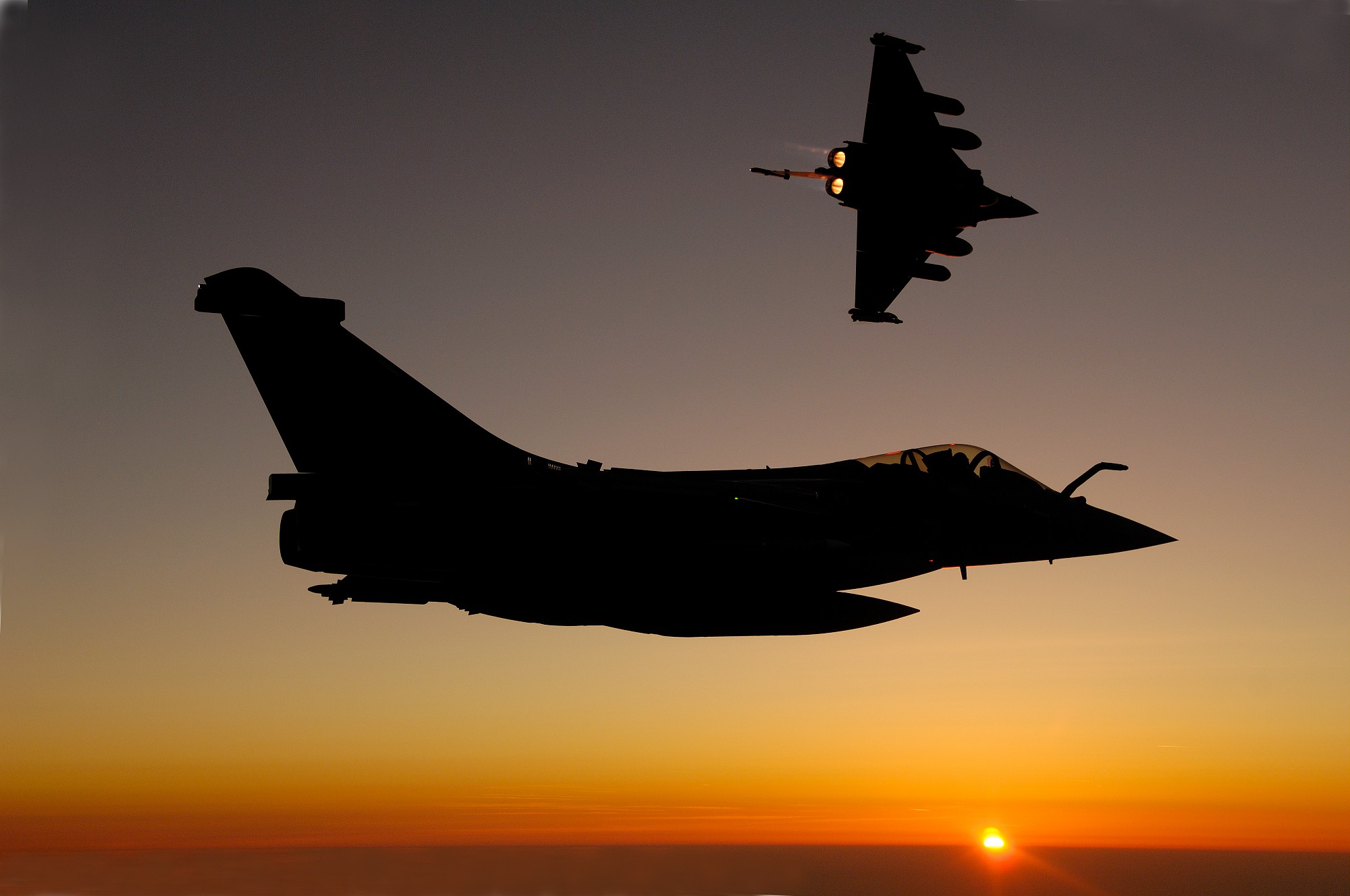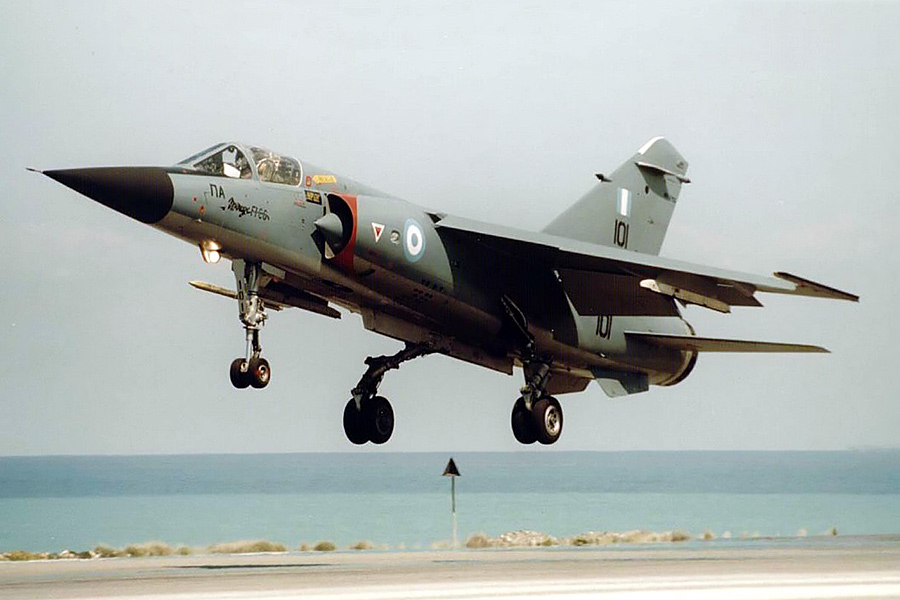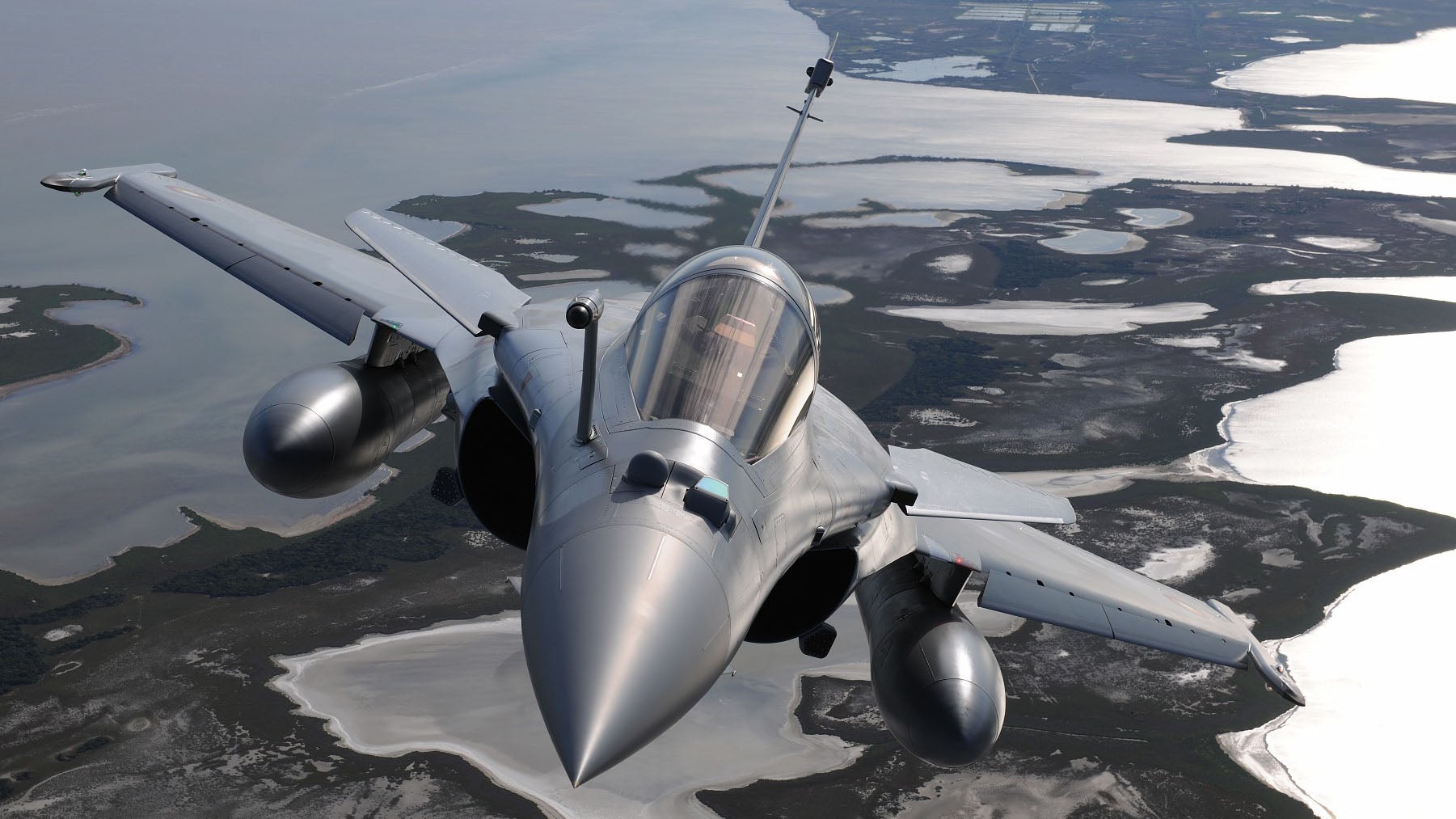As the standoff between Greece and Turkey in the Aegean rumbles on, Athens has announced steps to modernize all three branches of the Hellenic Armed Forces. The most significant development is Greece’s intention to purchase 18 Rafale jet fighters and four new multirole frigates. The Greek Prime Minister Kyriakos Mitsotakis announced plans during an address on the state of the economy at the Thessaloniki International Fair on September 12.
“In recent years, the defense sector has experienced disinvestment after a period of high costs and neglected the armament programs,” Mitsotakis said. “It’s time to balance needs and opportunities. It is time to strengthen the Armed Forces as a legacy for the security of the country. But also as a supreme obligation to the Greeks, who will bear the cost. It is the price of our place on the map.”
Rafales for the HAF
The 18 Rafales are set to replace the Hellenic Air Force’s (HAF) older Mirage 2000s that have not been brought up to the more advanced Mirage 2000-5 Mk 2 standard. Prime Minister Mitsotakis has said that the HAF will receive six new-build Rafales and 12 second-hand examples diverted from French Air Force stocks. According to unconfirmed French sources, the second-hand jets will be delivered in the F3-O4T standard that includes RBE2 active electronically scanned array(AESA) radar, DDM-NG infrared missile warning system, OSF-IT optoelectronics system, and improved cockpit displays.

“I am delighted with this announcement, which reinforces the exceptional relationship we have had with Greece for nearly half a century, and I thank the Greek authorities for their confidence in us once again,” said Eric Trappier, Chairman and CEO of Dassault Aviation. “Dassault Aviation is fully mobilized to meet the operational needs expressed by the Greek Air Force, and thus contribute to ensuring Greece’s sovereignty and the safety of the Greek people.”
For Dassault, the planned Greek acquisition of the Rafale is a major breakthrough. Once signed off, it will be the first European export order of the multirole fighter, which has already been ordered by Egypt, India, and Qatar.
“Armed Forces Minister Florence Parly welcomes the choice announced today by Prime Minister Mitsotakis to acquire 18 Rafale aircraft,” the French Ministry of Defense said in a statement. “This choice strengthens the link between the Greek and French armed forces and will allow them to intensify their operational and strategic cooperation.” According to the same source, a contract for the Rafales should be signed “in the coming months.” According to Prime Minister Mitsotakis, the first Rafales for the HAF should arrive in Greece in the middle of 2021.
Recent military cooperation between France and Greece has also involved Rafales. On August 13, French Air Force Rafales arrived at Souda-Chania Air Base on Crete for joint training with Greek F-16s. The French Ministry of Defense described the deployment as a “temporarily strengthening [of] their presence in the eastern Mediterranean.”
The spending plan also includes new guided missiles for the air force. While these remain undisclosed, it’s highly likely that this element comprises weapons for the Rafales. The HAF already employs MBDA MICA air-to-air missiles on its Mirage fleet, which also carry AM.39 Exocet anti-ship and SCALP-EG conventionally armed cruise missiles from the same manufacturer. All three of these weapons, and more, can be carried by the Rafale too.
In a time of conflict, the Rafales would likely be expected to secure air superiority over the region, including operating from dispersed island bases, while also prosecuting long-range land-attack missions and anti-shipping strikes. You can read all about how Greece and Turkey currently stack up against each other air combat-wise in this past feature of ours.

Some sources erroneously state that the deal will include the modernization of 10 of the HAF’s earlier Mirage 2000s to the more advanced Mirage 2000-5 configuration. This, however, runs counter to reports from Greece that the Rafales will replace the surviving non-upgraded Mirage 2000s. It seems that these reports of Mirage modernization have conflated the latest plans with the previous contract to upgrade 10 Mirage 2000s to 2000-5 standard, now completed.
Meanwhile, in December 2019 further contracts were signed for the continued maintenance of the Greek Mirage 2000-5 fleet. This €260-million deal covered upgrade and sustainment of the jets’ electronics and its engines over a seven-year period, with work to be conducted by Dassault Aviation, Safran Military Engines, and Thales.
A long-term observer of the Hellenic Air Force told The War Zone that they expect the older Mirage 2000s to be sold back to France or possibly to Cyprus. The latter would seem surprising since it doesn’t currently operate any fixed-wing combat equipment.
The Greek decision to opt for the Rafale could signal the end of official interest in the F-35 Lightning II. In December 2019, Prime Minister Mitsotakis revealed that he would be discussing a potential purchase of the Joint Strike Fighter with U.S. President Donald Trump during a visit to the White House the following January.
“We can deepen our defense cooperation even further, for example in the sector of drones. We will also begin a discussion on eventually acquiring F-35 aircraft, once fiscal conditions permit,” Mitsotakis told Greek newspaper To Vima, at the time.
The Greek prime minister’s mention of “fiscal conditions” suggests that an F-35 purchase may have been shelved on cost grounds, with the Rafale option coming in cheaper. On the other hand, the HAF has long operated fighters from both France and the United States, perhaps to ensure a continued supply chain for at least one of the fleets, should a potential conflict trigger sanctions or other restrictions.
Dassault’s Greek odyssey
Greece has been an enthusiastic customer of French-made combat jets for over 45 years. This began with an order for 40 Mirage F1CG fighters in June 1974. Unusually, the Greek Mirage F1s were armed with American-supplied AIM-9P Sidewinder air-to-air missiles and had a primary air defense tasking. After serving with two squadrons — 334 and 342 Mira — the last HAF Mirage F1s were retired in 2003.

In 1985, Greece chose to supplement the swept-wing Mirage F1 with the delta-wing Mirage 2000, placing an order for 36 single-seat Mirage 2000EGs and four two-seat Mirage 2000DGs.
After Dassault Aviation launched the more advanced Mirage 2000-5 Mk 2, Athens in 2000 chose to buy 15 examples and upgrade 10 of its existing Mirage 2000EGs to the same standard, with much of the modernization work handled locally by HAI.
The HAF ‘Dash 5s’ are designated Mirage 2000-5EG (single-seat) and Mirage 2000-5BG (two-seat). As well as the 10 new-build Mirage 2000-5EGs and 10 Mirage 2000EGs rebuilt to the same standard, the HAF received five new-build two-seat Mirage 2000-5BGs. HAF Mirage 2000s are divided between 331 and 332 Mira both based at Tanagra.
The new-look ‘French contingent’ within the HAF will likely see the Rafales assigned to 331 Mira while the Mirage 2000-5s serve with 332 Mira.

Naval regeneration
When the news was first announced, some observers presumed that the new frigates would be from French shipyards, but this is not necessarily the case. A U.S. investor took over Greece’s troubled Elefsis Shipyard earlier this year, which would provide the option to construct at least some of the warships locally. The planned acquisition of MH-60Rs also suggests that the warships could be of American design.
Alongside the four new frigates of an undisclosed type, the Hellenic Navy’s four existing MEKO 200HN frigates will undergo a mid-life upgrade.
The 3,200-ton MEKO 200HN, or Hydra class, is the Greek variant of the MEKO family of warships designed by the Blohm + Voss shipyard in Germany. The first of four Hellenic Navy vessels was constructed in Germany and commissioned in 1992 while the other three were completed locally by Hellenic Shipyards at Skaramagas.

Improvements to the Hydra class had been expected. Plans to upgrade the vessels were announced in April 2018, and in May 2019 the Joint Chiefs of General Staff Council decided to launch a modernization program albeit in a basic form, due to budgetary constraints. The full-scale mid-life upgrade is expected to address the radars, sensors, and electronic combat systems.
The maritime spending spree doesn’t end there, as Athens also plans to buy four new MH-60R Seahawk naval helicopters and provide its five air-independent propulsion (AIP) submarines with new heavyweight torpedoes.
The Hellenic Navy previously received eight S-70B Aegean Hawk helicopters — representing the previous-generation Seahawk — from the mid-1990s. The fleet added another three S-70B Aegean Hawks by 2005, these being configured to an improved standard including Raytheon AN/AAS-44forward-looking infrared (FLIR) for prosecuting anti-ship missile attacks using Hellfire or Penguin missiles.

Anti-tank weapons and cyber defenses
Meanwhile, the Hellenic Army is set to benefit from new anti-tank weapons, although the type has not been divulged. Also announced is a drive to improve digital technology across the Armed Forces, including hardening systems and infrastructure against cyberattacks.
As part of an overall expansion effort, the Hellenic Armed Forces will add another 15,000 personnel to its ranks over the next five years. The Greek military had around 107,600 servicemen and women in active service as of last year, a figure that has steadily increased since 2014.
Industrial overhaul
On the industry side, the rescue package for Elefsis Shipyard is expected to be followed by foreign investment in the country’s other major naval shipbuilder, Hellenic Shipyards at Skaramagas, according to local media. A tender has been launched for the privatization of Hellenic Vehicle Industries, the country’s only manufacturer of wheeled and tracked vehicles.
Finally, Hellenic Aerospace Industry (HAI) is expected to be reorganized with the aim of specializing in aircraft maintenance and overhaul.
Strategic issues
While the latest round of modernization for the Hellenic Armed Forces includes measures to boost the country’s defense industry, it should also be seen in the light of the ongoing tensions between Greece and Turkey in the eastern Mediterranean. These chiefly relate to disputes over energy claims and maritime rights in the region.
Sporadic clashes between the two countries are nothing new, but recent months have seen rival naval exercises, controversial drilling surveys, and a high-profile collision between Greek and Turkish warships.
New and modernized frigates and maritime helicopters, plus heavyweight torpedoes, demonstrate that the Hellenic Navy is expected to flex its muscles in the Aegean, where both Greece and Turkey have claims on overlapping areas, including important gas reserves — especially in the waters off Cyprus. The Mediterranean island remains a flashpoint between Ankara and Athens, with Turkey insistent that the island’s natural resources should be shared.
In August, Turkey reacted with anger when Greece signed a deal with Egypt to establish an exclusive economic zone (EEZ) in the Aegean. This followed an agreement between Turkey and Libya in November 2019, which sought to create an EEZ stretching from Turkey’s southern coast to northeast Libya, and which was protested by Greece and Egypt.
Meanwhile, Greece’s plan to buy 18 Rafale fighters signals a determination to establish a technological lead over the Turkish Air Force. Significantly, Turkey’s plans to acquire the F-35A were dramatically derailed after the country’s refusal to give up its purchase of Russian-made S-400 air defense systems. Should Ankara now seek to acquire a batch of fighters to match the Rafale, it’s options will be more limited. Turkey has been connected with the Russian Su-57 Felon in the past, but this fighter is still not yet in frontline service in Russia. A possible acquisition of the Su-35 is also on the table. It could be that the Turkish Air Force will have to wait until the indigenous TF-X enters service — optimistically scheduled for 2028 — until it can introduce new fighter equipment to offset the Greek Rafales, but this seems unlikely due to the need to replace aging types, including F-4 Phantoms.
The new frigates and Rafales will represent a significant improvement in the Hellenic Armed Forces’ capabilities in the Aegean. The planned purchases also send a clear message to Turkey that Greece is willing to invest to defend its interests in the region.
Contact the author: thomas@thedrive.com
